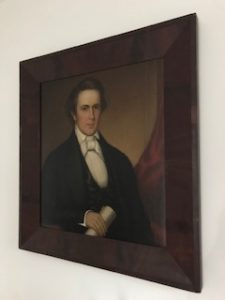Is an ancestor's portrait classy, or just pretentious?
I’m not saying we can’t learn from history, or that we shouldn’t honor our ancestors. It’s just that I never caught the genealogy bug. I’m quite nostalgic for periods and events of my youth, but not as much for looking back generations. I guess some folks need to look back because they need to build up their identities, but knowing who my genes come from is not that important to me. I know there are good stories back there, but shouldn’t we be making our own stories here and now? Besides, we kid ourselves if we think we can accurately imagine what their lives were really like.
One of the oldest things I own is a portrait of my great, great grandfather — the father of my great grandmother, whom I never met. It was likely painted at his home in the Virginia countryside, in the 1870s. All indications are that the artist was an itinerant painter who had already completed everything but the face.
I don’t like this painting. I don’t care if I ever see it again. But there it is on the wall of our dining room, so I see it many times each day. I inherited it because I inherited the subject’s first and middle names. When it hung in my grandparents’ library, I was scared of it. Or at least I enjoyed pretending to be scared of it. My cousins and I would say the eyes were following us. The face seemed so stern back then.
My wife likes the painting, ironically. She insists on displaying it, despite my continuing protests. She says she sees gentleness in the blue eyes, the soft lips. A Presbyterian minister and theology professor, my great, great grandfather owned slaves. Well, just one. Here’s the reason I say my wife’s admiration for the painting is ironic: She is a feminist. I think she might be the “hard-headed woman” Cat Stevens was seeking. She is, justifiably, a vehement critic of most male behavior. What bothers me most is the look of patriarchy. I don’t understand how she can so casually dismiss my discomfort at family holiday dinners, or when we have neighbors over. She apparently can’t grasp how it must look to them, with me sitting at the head of the table, and her answering the inevitable questions about the gentleman over my head. Yes, that’s it — the way it must look to others is a deep embarrassment to me. She wouldn’t admit it out loud, but I think my wife feels that having the portrait there is classy. Really it’s just pretentious.
So we go on, as we have for more than three decades now, in two different houses, rowing against the rapids of marriage. I know I’m stealing from the last paragraph of The Great Gatsby; how pretentious of me. Lately, I swear the reverend’s eyes are following me again.
###




Beautifully written, Ben, and this story leads in many provocative directions. It would be disturbing to find one’s ancestor owned slaves, even one. And, I can understand the disconnect between your wife’s feminism and her pride in the portrait. While I agree that we can’t realistically imagine what these ancestors’ lives were like, my own interest in genealogy grew because of being a Jew whose European past was largely erased. There is something satisfying about restoring even a tiny detail or locating a third cousin through a DNA match.
I understand your discomfort with the legacy of your great grandfather (and that his portrait creeped you out when you were a child; some portraits are famous for their ability to seem like their eyes follow you). But I still think it’s cool that you own it, despite who he was and what he did or didn’t do.
Thanks for sharing him with us.
What shall I say to you, Ben? Were it not for him, there would be no you. I am no relation (of course), but immediately (like your wife and likely your friends) I love this portrait. I have one (of a little boy unknown to me), and when he catches my eye I imagine anew his life story. Portraits pack a powerful punch; they are material evidence of American art history as well. I hope you can give (him) a little more time. He may yet grow on you!
Thanx Ben, for your well-written story and your honest appraisal of your relationship to great, great, granddad’s portrait.
Your wife doesn’t have the childhood associations with it you do, and it does look cool in the dining room. I’m with her!
I had to look up the final sentences of The Great Gatsby to not be “left ashore” with regard to the ending of your own piece. It turns out you only cribbed just a little.
I appreciate the contrarian approach to the prompt. Good for you: making your own stories. But what if that portrait was of a really unconventional looking street vendor or juggler ? Then you want it right up there above the head of the table, right?
Hmmmmmmmmm. Thinking…
I enjoyed reading about your ancestry captured in that painting, even if you borrowed a bit of F. Scott Fitzgerald.
An interesting insight into that painting–funny how prompts can take you on meanders you might not have known were going to happen. Knowing the names on a family tree may not appeal, but trying to sort out the mysteries can be more rewarding–putting together the stories told from census records (who lived with whom and where, plus listed occupations), or seeing little towns with ancestors’ names on gravestones. I recently enjoyed finding out (through sleuthing not my own) about a grandparent’s hidden second family. History becomes more alive, and the threads to today more appreciated. Doesn’t mean you have to like the painting though.